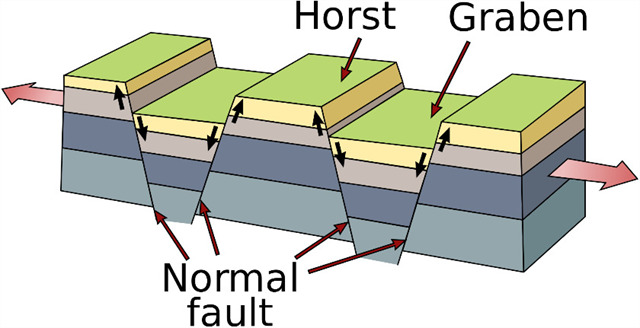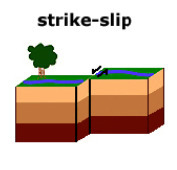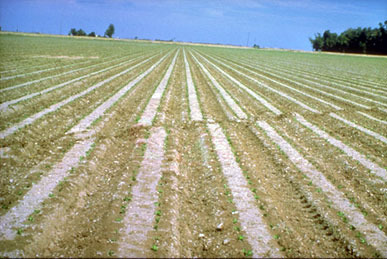You might be forgiven for thinking Stonehenge is in England and has been there for several thousand years but for those for whom a trek to England is a bit out of reach, you can find a full-size replica of what Stonehenge would have looked like in approximately 1950BC right here in Western Australia.
Esperance’s Stonehenge reproduction is made from locally quarried granite rock and compromises of 137 stones.
It can be found approximately 14 km east of Esperance town and is on private land. For opening hours please visit the website
http://esperancestonehenge.com.au/
This earthcache has been placed with the permission of the land owner.
This Earthcache lesson is all about Fractures, Faults and Joints
Fractures are breaks in rock caused by things such as temperature, pressure and strains.
There are two types of fracture
• Faults – these are fractures where there has been significant movement of the earth/rock
• Joints - where there is no appreciable movement, e.g. a stationary rock that has cracked
Faults.
Faults are formed in an area of weakness and occur along the plane of weakness. This makes movement easier to happen. Rapid movement at a fault causes earthquakes to be felt. The study of earthquakes and the faults which they occur along have been extensively researched to discover the history of the rocks and fault lines but also to learn about potential future earthquakes and predict when they could happen to give early warning. Faults can be singular and small or coalesce in an area called a fault zone. An example is the San Andreas fault which is actually lots of smaller faults all coalescing into a massive fault zone.
There are sub categories of faults - dip-slip, strike-slip and oblique faults and these can be further sub-categorized into normal or reverse, left lateral or right lateral. These faults are described in terms of a hanging wall and footwall component. If you were to place a miner within the rock along the fault line, then their feet would be stood on the footwall and the hanging wall above their head.

• Dip-Slip Faults – The rocks move in the vertical plane. A normal dip-slip fault results in the hanging wall moving down with respect to the footwall and the reverse dip-slip fault is the opposite

http://donsnotes.com/reference/earthquake_glossary.html

Seppapo Gorge Morocco By Franck Bouttemy http://www.geodiversite.net/auteur197 - http://www.geodiversite.net/media1015, CC BY-SA 3.0, https://commons.wikimedia.org/w/index.php?curid=30139674
Where the fault line is at an angle of less than 45 degrees the reverse dip-slip fault is called a thrust fault.
In areas where there are multiple normal dip-slip faults occurring, you can end up with raised and lowered levels of rock. The raised levels are called Horst and the lower levels Graben

By Horst_graben.jpg: U.S. Geological Surveyderivative work: Gregors (talk) 11:17, 7 June 2011 (UTC) - Horst_graben.jpg, Public Domain, https://commons.wikimedia.org/w/index.php?curid=15432947
• Strike-Slip Faults – The rocks move in the horizontal or lateral plain and are the result of shear forces at the plate boundaries. They can be Left Lateral or Right Lateral depending on which way they move.

http://donsnotes.com/reference/earthquake_glossary.html

San Andreas Fault - Photograph by (Cavit, D) U.S. Geological Survey
• Oblique Faults – These combine both dip-slip and strike-slip faults movement.

By Codking - Own work, Public Domain, https://commons.wikimedia.org/w/index.php?curid=8307689
Faults aren’t always a bad thing. Mining capitalises on fault planes. For instance, oil can move through permeable rock layers and get trapped at the fault line where it can then be drilled for. Water can seep through rocks carrying minerals which get deposited in joints, again these seams can be mined and the minerals brought to the surface.
Joints
A joint is a fracture along which no displacement has occurred.
There are three types of joint.
• Columnar joints an example of which is the Giant’s Causeway in Northern Ireland.
• Exfoliation joints or sheet joint – Yosemite Park has examples where the rock appears to be layered in sheets. These can form in granite rock.
• Tectonic joints – which are breakages in a systematic form. These are the most common joint found in nature and are simply caused by stresses in the area.
There are other explanations
• Cracking – can occur in clay as the mud dries out and the clay shrinks
• Columnar jointing is a result of lava flow cooling
• Granite can expand which causes an exfoliation layering to develop
• At Arches Natural Monument the explanation of the sandstone fins comes from salt rising through the sandstone causing it to crack with subsequent weathering resulting in the arches forming
• Breakage can simply be due to the weight of the buried rock
Questions.
Take a look at the granite rocks at this earthcache site. Some of the rocks have a distinct diagonal mark in them.
1. What type of fracture has occurred here?
2. What colour is the marking?
3. Is this deposit likely to have seeped through the granite or been deposited along the fracture?
4. What could be deposited here to create this coloured marking?
5. How wide do you estimate this fracture to be?
Optional photography. We would love to see a photo of you at Stonehenge. Feel free to add a photograph to your log.
You are welcome to log this Earthcache after sending your answers to us. If no answers are received, or they are unsatisfactory your log will be deleted. Please be mindful of your logs to ensure there are no spoiler images/answers for the questions above. Spoilers will also be removed.
References:
Wikipedia
Geology.com
Congratulations on FTF Daynaduc and that is going to be one hard photograph to beat!